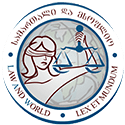| ციფრული იდენტიფიკატორი |
| doi.org/10.36475/L.A.W.14 |
| შემოკლება |
| L.A.W. |
| გამოცემა |
| ელ.ვერსია |
| ბეჭდური |
ამ სტატიაში
Volume 8, Issue 2
International Legal Basis For The Right To Defense In The Cyber Era
Affiliation: Professor, Business and Technology University
Abstract: Against the background of the growing development of information and communication technologies and the digital transformation of various fields, it has become possible to produce war using digital tools. Today a cyberattack can cause similar or more damage than a conventional operation. This, in turn, changes the traditional perception of armed attack and creates the possibility to say that cyberattacks may significantly harm the countrys defense capabilities, and security, and impede the development of the society and state. Illegal access to computer networks could cause substantial damage to the functions of the critical information system, the protection of which is directly related to the vital interests of the state. This fact leads to a new understanding of the international legal basis of the right to defense. In particular, the purpose of the article is to analyze whether a cyberattack is the international legal basis that enables a state to exercise the right of defense and protect its sovereign interests.
Keywords: Cyberattacks, Defense, State, Non-state Actors
Language: EN
ბიბლიოგრაფია:
- Chayes, A., (2015). “Rethinking Warfare: The Ambiguity of Cyber Attacks”, 6 Harvard National Security Journal
- Case Concerning Military and Paramilitary Activities in and against Nicaragua (Nicaragua v. the United States of America), 1986;
- Case Concerning Oil Platforms (the Islamic Republic of Iran v. the United States of America), ICJ, (2003). http://www.icj-cij.org/docket/files/90/9745.pdf
- Charter of the United Nations, http://www.update.un.org/en/documents/charter/intro.shtml
- Voitasec, D., (2015). Applying International Humanitarian Law to Cyber-Attacks, 22 Lex ET Scientia International Journal;
- Founding Treaty – the North Atlantic Treaty, (April 4, 1949). https://www.nato.int/cps/en/natohq/topics_67656.htm
- Frederick H. Russel, (1975). The Just War in the Middle Ages;
- Johnson, J. Turner., (1975). Ideology, Reason and the Limitation of War;
- Gardam, J. Gail., (July 1, 1993). “Proportionality and Force in International Law”, American Journal of International Law;
- Pipyros, K., Thraskias, Ch., Mitrou, L., Gritzalis, D., & Apostolopoulos, T., (2018). “A new strategy for improving cyber-attacks evaluation in the context of Tallinn Manual”, 74 Computers and Security;
- Michael N. Schmitt, (2003). “Preemptive Strategies in International Law”, Michigan Journal of International Law;
- Michael N. Schmitt, (Spring, 2014). “The Law of Cyber Warfare: Quo Vadis?”, 25 Stanford Law & Policy Review;
- Hathaway, O. A., Crootof, R., Levitz, P., Nix, H., Nowlan, A., Perdue, W., & Spiegel, J. (2012). “The Law of Cyber-Attack”. 100 California Law Review
- Moore, S., (2013). “Cyber Attacks and the Beginnings of an International Cyber Treaty”, 39 The North Carolina Journal of International Law and Commercial Regulation;
- Tallinn Manual 1.0 on the International Law Applicable to Cyber Warfare, (Michael N. Schmitt, ed.), Cambridge University Press;
- The Wales Summit Declaration issued by the Heads of State and Government participating in the meeting of the North Atlantic Council in Wales, (4-5 September 2014). https://www.nato.int/cps/ic/natohq/official_texts_112964.htm
- The Warsaw Summit Communiqué issued by the Heads of State and Government participating in the meeting of the North Atlantic Council in Warsaw, (8-9 July 2016). https://www.nato.int/cps/en/natohq/official_texts_133169.htm
- Dinstein, Y., (2005). “War, Aggression and Self-Defence”, Fourth Edition, Cambridge University Press
სქოლიო:
- Tallinn Manual 1.0 on the International Law Applicable to Cyber Warfare, (Michael N. Schmitt, ed.), Cambridge University Press, (2013), 106.
- Charter of the United Nations, http://www.update.un.org/en/documents/charter/intro.shtml [Last seen: June 2022].
- Nicaragua v. the United States of America, (1986). Case Concerning Military and Paramilitary Activities in and against Nicaragua, p. 93.
- Dinstein, Y., (2005). “War, Aggression and Self-Defence”, Fourth Edition, Cambridge University Press, pp. 165-169.
- Moore, S., (2013). Cyber Attacks and the Beginnings of an International Cyber Treaty, 39 The North Carolina Journal of International Law and Commercial Regulation, p. 247.
- Id., at 248.
- Id
- Id
- Hathaway, O. A., Crootof, R., Levitz, P., Nix, H., Nowlan, A., Perdue, W., & Spiegel, J. (2012). The Law of CyberAttack. California Law Review, 100(4), p. 847.
- Pipyros, K., Thraskias, Ch., Mitrou, L., Gritzalis, D., & Apostolopoulos, T., (2018). “A new strategy for improving cyber-attacks evaluation in the context of Tallinn Manual”, 74 Computers and Security, p. 375
- Id
- Chayes, A., (2015). “Rethinking Warfare: The Ambiguity of Cyber Attacks”, 6 Harvard National Security Journal, p. 482.
- Michael N. Schmitt, (Spring, 2014). “The Law of Cyber Warfare: Quo Vadis?”, 25 Stanford Law & Policy Review p. 287
- Voitasec, D., (2015). Applying International Humanitarian Law to Cyber-Attacks, 22 Lex ET Scientia International Journal, p. 126.
- See supra note 1.
- See supra note 3, 84.
- Case Concerning Oil Platforms (the Islamic Republic of Iran v. the United States of America), ICJ, (2003). http://www.icj-cij.org/docket/files/90/9745.pdf [Last seen: June 14, 2022].
- Michael N. Schmitt, (2003). Preemptive Strategies in International Law, Michigan Journal of International Law, p. 533.
- Gardam, J. G., (July 1, 1993). “Proportionality and Force in International Law”, American Journal of International Law
- See James Turner Johnson, Ideology, Reason and the Limitation of War (1975); Frederick H. Russel, The Just War in the Middle Ages (1975).
- See supra note 18, at 532
- See supra note 1, 15, at 62.
- Id., at 62-63.
- Id., at 63.
- Id., at 67.
- Founding Treaty – the North Atlantic Treaty, (April 4, 1949). https://www.nato.int/cps/en/natohq/topics_67656.htm [Last seen: April 29, 2022].
- The Wales Summit Declaration issued by the Heads of State and Government participating in the meeting of the North Atlantic Council in Wales, (4-5 September 2014). https://www.nato.int/cps/ic/natohq/official_texts_112964.htm [Last seen: April 29, 2022].
- The Warsaw Summit Communiqué issued by the Heads of State and Government participating in the meeting of the North Atlantic Council in Warsaw, (8-9 July, 2016). https://www.nato.int/cps/en/natohq/official_texts_133169.htm [Last seen: April 29, 2022].
| გამოქვეყნების საფასური |
| უფასო |
| მთავარი რედაქტორი |
| იოსებ კელენჯერიძე |
| გამოქვეყნების ენა |
| ინგლისური |
| ქართული |
Copyright ©2022 ყველა უფლება დაცულია









